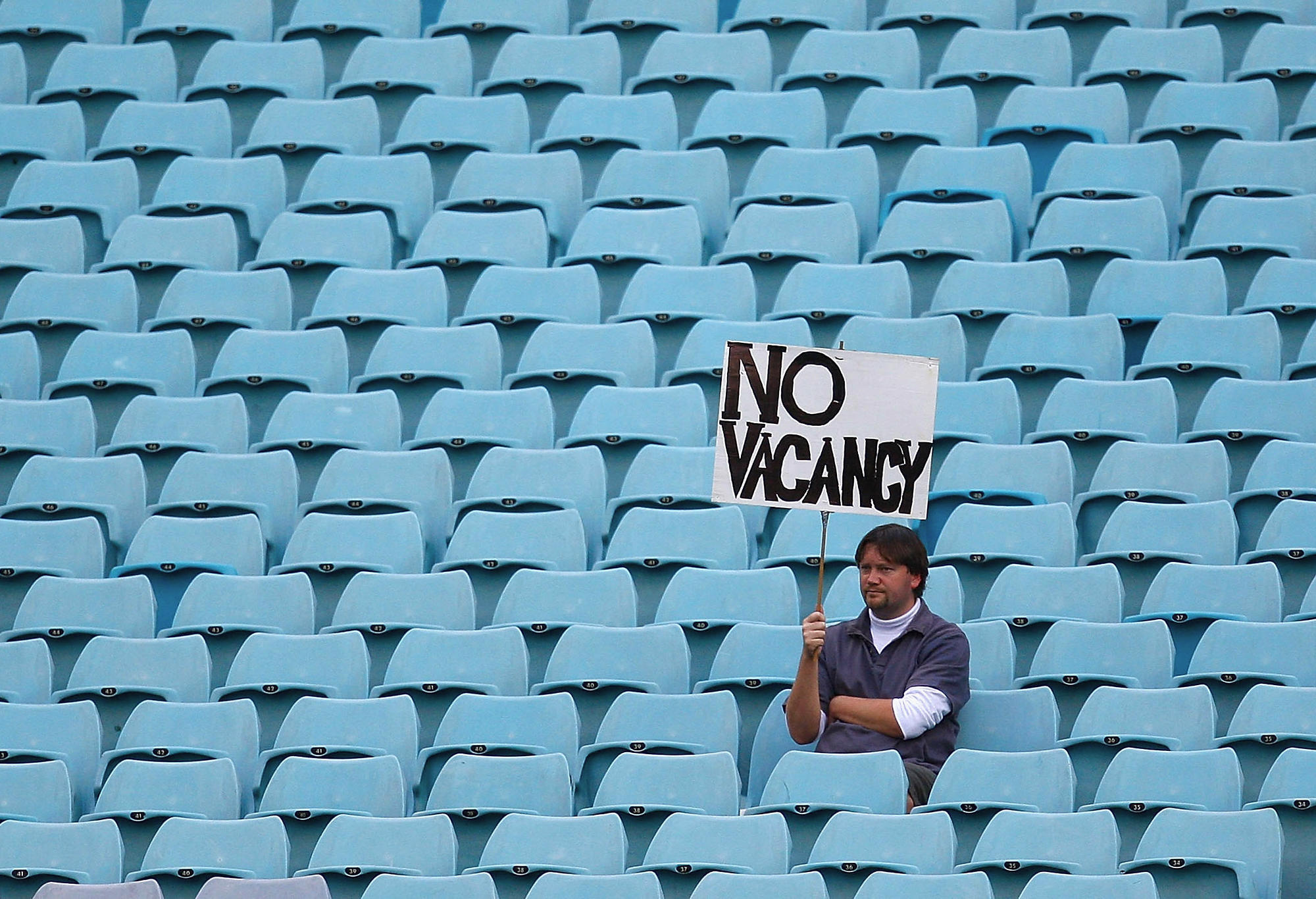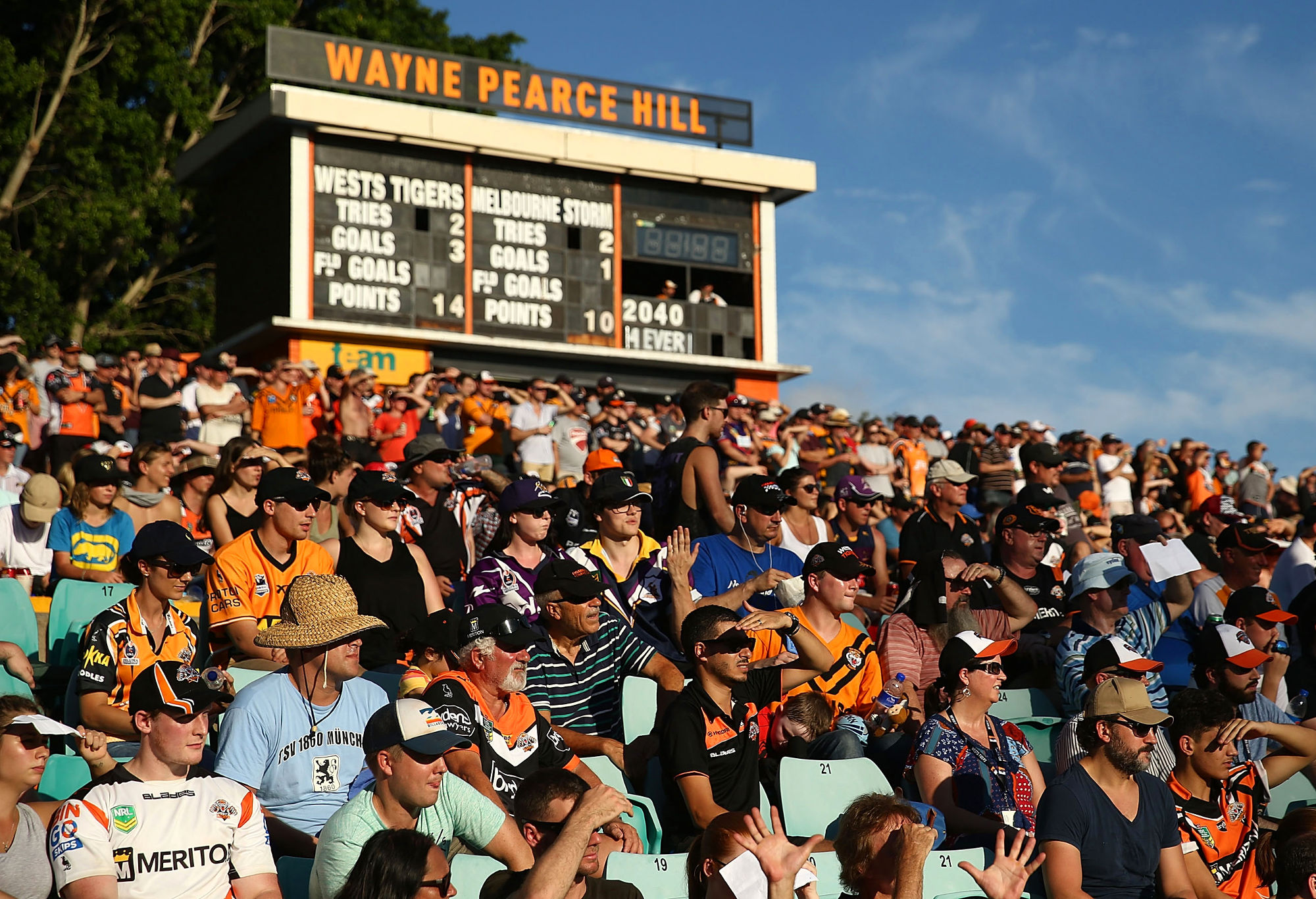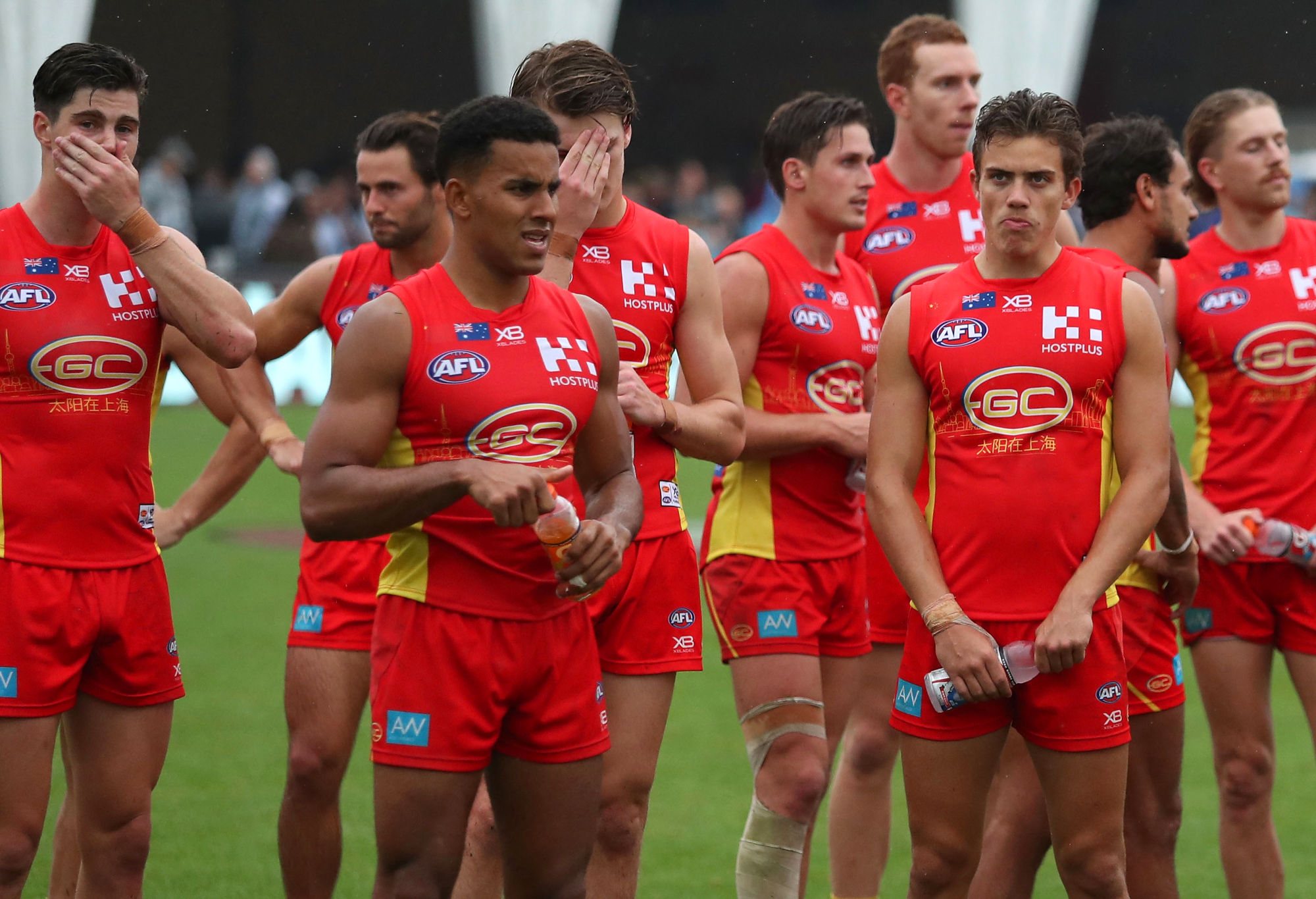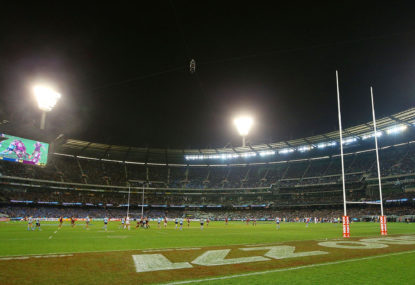Come together.
No, not in that way. Get your minds out of the gutter! I’m talking about some of the AFL, rugby union and rugby league teams coming together to reduce the number of teams in each of these competitions.
There are too many teams. The powers that be should be optimising bums on seats at stadiums (BOSAS), eyes on screens (ESS), and the standard and intensity of play (SOPI). They should also be optimising value for money (VFM) for punters forking out a month’s beer money on match tickets for their families.
I am pretty confident neither BOSAS, ESS, SOPI or VFM have been optimised by adding teams to these competitions. The AFL has 18 teams, the NRL has 16, and Super Rugby has 15.
One of the issues with reducing the number of teams is emotions get in the way of cold, brutal and rational decision making. The members and supporters of individual teams get upset, throw their remotes at walls and pets and vent on social media when they hear proposals to merge teams or to cut teams altogether.
Perhaps we should have a look at what the Americans have done. For example, if teams in the NFL, MLB, NBA, or MLH aren’t working in their geographic markets, the owners just move them to a different city. Either that, or it’s the end of the road. Adios and muchas gracias for coming.
And, guess what, fans get over it. They cry for a week or a month or even an entire season, boycott their old team, spit the dummy and whinge to anyone who cares to listen. But, sport is a business. Having sub-optimal BOSAS, ESS, SOPI and VFM are not “good for business”, to borrow the term the WWE’s scriptwriters made popular.
Bums on seats at stadiums
The NFL comprises 32 teams. Including the people Mr Trump doesn’t want, the US has a population of least 325 million. That’s around one team for every 10 million people. The English Premier League has 20 teams – one team per 2.6 million people. Germany’s Bundesliga has 18 teams – one team for every 4.6 million people.
With 18 AFL teams, there’s a team for every 1.4 million people. In rugby league, there’s one team for every 1.6 million. You can’t do the same kind of comparison for Super Rugby because two of the countries involved have a combined population of around 160 million and union is a mini-sport in those countries. In addition, socio-economic and other related issues come into play in South Africa with a population of 56 million.
So what, you ask. In the countries mentioned above, BOSAS figures are far more impressive than Australia. The number that matters is percentage of stadium capacity to take into account differences in population sizes.
NFL, EPL and the Bundesliga
In 2016, 13 NFL teams filled their stadiums to capacity, another 15 stadiums were 90 to 99 per cent full, with the rest in the high 80s. Even cellar dwellers Cleveland Browns had 88 per cent of their seats filled.
The BOSAS number in the EPL is also pretty impressive with all but one team filling their stadium to at least 90 per cent capacity (the anomaly was Tottenham who has to play at 90,000 seat Wembley Stadium until their new ground is finished: even they managed get 75 per cent of the seats filled with an average of 67,000 per match). The story is similar in the Bundesliga, with most stadiums selling 90 per cent or more of their seats.
AFL Attendances
Almost 7 million people attended AFL home and away matches in 2018. This is around 318,000 per week. The combined capacity of stadiums hosting AFL matches in 2018 was 497,000. This means on average, stadiums were around 64 per cent full.
NRL Attendances
2.9 million people attended NRL matches during the 2018 home-and-away season. That’s around 116,000 BOSAS a week. The combined capacity of stadiums hosting NRL matches in 2018 was 402,000. This means on average, stadiums were around 28 per cent full.

(Photo by Cameron Spencer/Getty Images)
Super Rugby Attendances in Australia
357,000 people attended the 32 Super Rugby matches played in Australia in 2018. That’s an average of around 11,000 per match. The average capacity of the stadiums at which Super Rugby matches were played in Australia was around 38,000. This means stadiums were around 29 per cent full.
Impact of Increasing BOSAS
These numbers mean Australian sporting stadiums for these three codes of football are severely under-utilised. In other words, they are a bit of a waste of space.
In terms of capacity utilisation, the impact of merging teams would likely lead to higher average attendances per stadium (even after the whining and teeth gnashing). If we reduced the AFL to 14 teams, the NRL to 12 and the Super Rugby competition to 10, we could see a dramatical increase in the average. The AFL has already done a good job of consolidating stadiums so that the 12 Victorian-based teams only use three stadiums. The NRL hasn’t done any kind of job in this regard at all.
The fixed operating costs of a stadium are probably not much different whether its 80 per cent or 30 per cent full. However, as BOSAS increases, profitability increases accordingly. For example, if the fixed cost of operating a 50,000 seat stadium is $500,000 a game and you sell 20,000 tickets at $50, you make a gross profit of $500,000. But, if you sell 40,000 tickets at the same price, you make a gross profit of $1.5m – and, yes, you need to hire more people to operate a stadium with 40,000 patrons, but that might be reasonably marginal.
Eyes on screens
To increase revenue from advertising, sponsorship broadcasting and streaming rights, the number of eyes on screens has to increase. This doesn’t necessarily mean spending more on marketing. I have a sneaking suspicion if BOSAS increases (as a result of team mergers), so will ESS.
Maybe it’s just me, but part of the enjoyment of watching a game of any code of football is seeing full or nearly full stadiums and hearing the crowd roar, particularly with HD TVs, sound bars and sub-woofers.
Maybe there’s a kind of “I wish I were there” syndrome.
Excitement levels might be enhanced by an increase in BOSAS and that could translate to more ESS, without spending much on additional marketing past the first few weeks of a season.
If you reduce the number of teams, you could end up with more viewers per match because there are less matches to watch and at least the same number of people will want to watch (once they have completed their intensive therapy programs to deal with the grief of the loss of their teams). You should also get more viewers in total because the SOPI will increase after the mergers have settled down.
There’s also a potential flow-on effect from higher ESS and BOSA. That is, when people watch an event in which the excitement level is enhanced by a fuller stadium they could be more likely to want to go to a match in the future, particularly if VFM also increased.

(Photo by Mark Metcalfe/Getty Images)
In addition, if they go to a match where there is a big crowd and great atmosphere, they are more likely to go to more matches in the future.
Standard and intensity of play
The standard of play and intensity in international matches of rugby union or in State of Origin is superior to most home-and-away matches. The same used to be the case when we had interstate matches in Australian Rules. This is because the teams comprise the best of the best.
By reducing the number of teams, the ratio of players to available slots increases. Players, therefore, have to become better to get a jumper and each team has higher quality players from which to select. Some economists think that higher competitive intensity leads to improvements in the quality of products and services.
By expanding the number of teams, the powers that be in the various codes have diluted the player pool. I recently watched some Australian Rules matches from the 1970s and 1980s. In the 1972 grand final between Carlton and Richmond you had Jezza, Keogh, Jones, Nicholls, Walls, Jackson, Robertson, Doull, McKay, Waite, Southby (Carlton) and Bartlett, Hart, Balme, Richardson, Bourke, Hunt, Sheedy and Clay (Richmond) on the same field at the same time.
You can’t do that today. There hasn’t been that many players of that calibre on the field at the same time for a couple of decades at least. The salary cap would not allow it and 12 teams has become 18.
The talent is spread too thin so that you can only have a couple of hall of fame-level players on a team. In those days you could have eight or ten on the paddock at the one game.
Same goes for the other codes. Spreading the talent pool by increasing the number of teams has done nothing to improve SOPI.

(Photo by Sean Garnsworthy/AFL Media/Getty Images)
Value for money
Except for my divorce lawyer (who drives a BMW M5, thanks, in part, to me), I haven’t yet spoken to anyone who thinks that ticket prices to matches in any code are particularly good value. I wonder what would happen to attendance numbers if ticket prices were reduced, and what would be the impact on revenue from ticket sales, merchandise sales, ground advertising and TV advertising.
Attendances would increase the total revenue from ticket sales. 40,000 people paying an average of $40 generates a total of $1.6m while 30,000 paying an average of $60 generates only $1.2m.
I also suspect that merchandise sales would increase because there are more people at the game.
In addition, the asking price for TV and streaming rights might increase because broadcasters could demonstrate the higher ESS to advertisers.
To improve VFM even more, a loyalty program where people attending a certain number of matches at the same stadium in a season would get price reductions the following season for higher grades of seats. This could increase repeat attendances and improve revenue and attendance forecasting. If you know how many people are going to turn up, you can charge more to advertise.
The demand for premium tickets is reasonably price inelastic (that’s the extent of my knowledge of economics terms). Those with money to burn might think you can’t get the same enjoyment from watching a game on TV or online as you can by being there. Those without money to burn have to watch the game on a screen or might only be able to attend one or two games a season.
Is demand for non-premium tickets sufficiently elastic to increase total revenue by reducing the price? And, if so, by what percentage would the price need to be reduced to increase average attendances to 85 per cent in the AFL, and to 70% in the NRL and the Super Rugby competition, combined with the other measures suggested previously.
NFL teams are able to charge hundreds of dollars because demand is far higher than supply. For some matches, you probably could sell two or three times the stadium’s capacity. The NFL has optimised BOSAS, and has probably also optimised ESS (at least for the blockbuster games), and SOPI. It seems that VFM in the NFL has been optimised judging by BOSAS.
Where should the money go>?
So, if the codes make more money, where should it go?
For a start, the price of a pie and a beer needs to drop to something resembling sanity. Almost as importantly, more money can be invested in upgrading the playing surfaces of junior and lower-tier pitches, improving the training for youth coaches, referees and officials, improving training equipment and facilities at junior level, training administrators in feeder clubs in running a business properly, improving player welfare, income protection and retirement programs.
In the rugby codes, you would have more money for player salaries to encourage them to play in Australia and represent Australia instead of going to England, France or Japan. You could increase the salary cap, increase the average salary and the minimum salaries for rookies.
You could also provide all players with finance, business and personal development coaching. Every player needs a plan for what they do after their career finishes. And young players in their late teens and early 20s being paid two or three times the average salary need mentors and advisors.
































































































